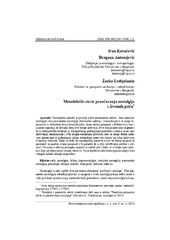Metodološki okvir proučavanja nostalgije i životnih priča
The methodological framework for the study of nostalgic and personal narratives
| dc.creator | Kovačević, Ivan | |
| dc.creator | Antonijević, Dragana | |
| dc.creator | Trebješanin, Žarko | |
| dc.date.accessioned | 2021-10-12T11:46:53Z | |
| dc.date.available | 2021-10-12T11:46:53Z | |
| dc.date.issued | 2013 | |
| dc.identifier.issn | 0353-1589 | |
| dc.identifier.uri | http://reff.f.bg.ac.rs/handle/123456789/1653 | |
| dc.description.abstract | Nostalgični narativi se javljaju u dva dominantna oblika - kao istorijske nostalgije i kao personalne nostalgije. Personalni sadržaji i istorijske priče se mogu registrovati u slobodnoj formi životnih priča, žanra dobro poznatog u folkloristici, kao i u narativima koji se dobijaju kroz dve forme intervjua. Prva forma intervjua se generiše iz antropološke tradicije tj. etnografskog prikupljanja podataka i odnosi se na opis društvenih, ekonomskih i svih drugih elemenata prošlosti, dok se druga forma intervjua, generisana iz psihologije, slična dubinskom intervjuu, odnosi na lične doživljaje iz ranijeg vremena. Kada se dođe do nostalgičnih narativa u ove tri forme moguće je sprovesti: a) analizu svake ponaosob i b) porediti ih u cilju utvrđivanja razlika i sličnosti. Na osnovu takvog postupka moguće je otkriti gde i kako se stvaraju opisi prošlosti koji ne odgovaraju ličnom iskustvu, što je karakteristika kako jugo-nostalgije tako i drugih sličnih sećanja na prošlost. | sr |
| dc.description.abstract | Nostalgic narratives occur in two major forms - as historical nostalgias and as personal nostalgias. Personal contents and historical stories can be registered in the free form of life stories, a well-known genre in folkloristics, as well as in narratives obtained through two forms of interview. The first form of interview is generated from anthropological tradition, or rather, ethnographic data gathering and refers to descriptions of social, economic and all other elements of the past, while the other form of interview, generated in psychology, similar to an in-depth interview, refers to personal experiences from an earlier time. When nostalgic narratives are collected using either of these two approaches, it is possible to a) conduct an analysis of each narrative on its own, or b) compare them in order to determine similarities and differences. Based on this it is possible to determine where and how descriptions of the past which do not coincide with personal experience are generated, which is the main characteristic of both yugonostalgia and other similar ways of remembering the past. | en |
| dc.publisher | Univerzitet u Beogradu - Filozofski fakultet - Odeljenje za etnologiju i antropologiju, Beograd | |
| dc.relation | info:eu-repo/grantAgreement/MESTD/Basic Research (BR or ON)/177022/RS// | |
| dc.relation | info:eu-repo/grantAgreement/MESTD/Basic Research (BR or ON)/177035/RS// | |
| dc.rights | openAccess | |
| dc.rights.uri | https://creativecommons.org/licenses/by/4.0/ | |
| dc.source | Etnoantropološki problemi | |
| dc.subject | Srbija | sr |
| dc.subject | sećanje | sr |
| dc.subject | personalna nostalgija | sr |
| dc.subject | pamćenje | sr |
| dc.subject | nostalgija | sr |
| dc.subject | metodi | sr |
| dc.subject | lične priče | sr |
| dc.subject | jugosnostalgija | sr |
| dc.subject | istorijska nostaglija | sr |
| dc.subject | dubinski intervju | sr |
| dc.subject | yugonostaliga | en |
| dc.subject | Serbia | en |
| dc.subject | remembering | en |
| dc.subject | personal nostalgia | en |
| dc.subject | personal narratives | en |
| dc.subject | nostalgia | en |
| dc.subject | memory | en |
| dc.subject | in-depth interview | en |
| dc.subject | historical nostalgia | en |
| dc.title | Metodološki okvir proučavanja nostalgije i životnih priča | sr |
| dc.title | The methodological framework for the study of nostalgic and personal narratives | en |
| dc.type | article | |
| dc.rights.license | BY | |
| dc.citation.epage | 963 | |
| dc.citation.issue | 4 | |
| dc.citation.other | 8(4): 945-963 | |
| dc.citation.rank | M24 | |
| dc.citation.spage | 945 | |
| dc.citation.volume | 8 | |
| dc.identifier.doi | 10.21301/eap.v8i4.3 | |
| dc.identifier.fulltext | http://reff.f.bg.ac.rs/bitstream/id/549/1650.pdf | |
| dc.type.version | publishedVersion |

